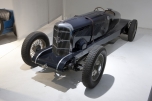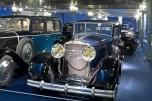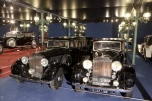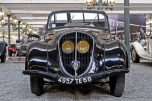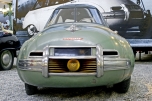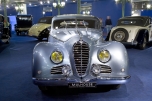Cars from 1920 to 1950 - The golden age of the car
Bugatti Type 35B
1929
Code 0101
Body style: two-seat racer
The different variants of the Type 35 racer that were built between 1924 and 1930 still typify the style of Grand Prix racers from the late 1920s and early 1930s, just as striking even sixty years later. The first Type 35s featured in the Grand Prix de l’Automobile Club de France in Lyon in 1924. They were immediately admired for their perfect balance and blend of aerodynamics and aesthetics: the aluminium body that fitted the chassis like a glove, the slim horse-shoe radiator, the beautiful pointed tail and the lightweight alloy wheels with their broad spokes and internal brake drums. A new development on this model was the inclusion of a spare wheel. Changing the wheel rather than the tyre in the event of a puncture was much quicker. Drivers also appreciated its excellent handling, manoeuvrability and braking. These were the qualities that made the Type 35 the archetypal mid-20s racing car. Bugatti had already started to make a name for itself on European circuits since an early victory in 1911, but this little masterpiece meant it really started to take the world of motor racing by storm from 1924. Bugatti drivers clocked up no less than 1851 wins from 1924 to 1927, at the wheel of the Type 35 and similar models, making them the kings of the track and earning the car the nickname “Thoroughbred”. Ettore again made history with this revolutionary “thoroughbred”, by offering it for commercial sale. Wealthy motoring enthusiasts could buy an automobile that was nearly identical to the prototypes raced by the works team, and the Type 35, a works model, became a favourite of these “gentlemen racers”.
Competitors such as Alfa Romeo were quick to respond, and Ettore Bugatti had to get more power out of the strong 8-cylinder engine, increasing its size and adding a Roots-type supercharger. This gave rise to the Type 35B, with its 2261 cc engine churning out 140 hp at 5000 rpm.
The car on display was Fritz Schlumpf’s own personal model, and he raced it many times in hill climb races in Alsace as a young man. Similar models were able to get up to 210 kph (130 mph), as demonstrated by the records set, including at the new Linas-Montlhéry circuit, which opened in 1924.











